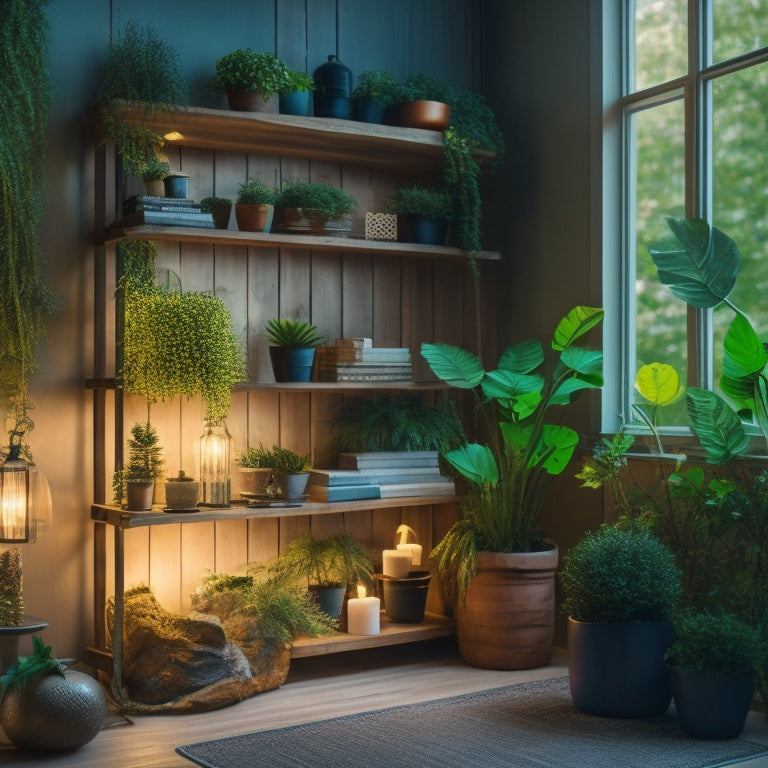
Cubby Shelving: Creating an Eco-Friendly Organizing Space With Solar Power
Share
By incorporating eco-friendly materials, harnessing solar power, and embracing sustainable design principles, you can create a cubby shelving system that not only maximizes storage space but also promotes a healthier, more environmentally conscious workspace. Choose reclaimed wood, bamboo, or low-VOC finishes to reduce your environmental footprint. Integrate solar panels to generate and store electricity, reducing your reliance on the grid. As you explore ways to merge sustainability and organization, discover how cubby shelving with solar power can transform your space into an eco-friendly oasis, and explore further to uncover the full potential of this innovative approach.
Key Takeaways
• Repurpose reclaimed wood or sustainably sourced materials to create eco-friendly cubby shelving units with unique character.
• Integrate solar power to generate and store electricity, reducing reliance on the energy grid and promoting energy independence.
• Utilize shelf dividers and storage bins for effective space planning, and label makers for easy item categorization and organization.
• Incorporate decorative trim and a thoughtful color scheme to enhance the aesthetic appeal of the eco-friendly cubby shelving unit.
• Choose low-VOC finishes, natural paints, and eco-friendly materials to create a healthier indoor environment and promote sustainability.
Designing Eco-Friendly Cubby Shelving
As you begin designing your cubby shelving, consider repurposing reclaimed wood or sustainably sourced materials to craft a unique, eco-friendly storage solution that not only organizes your space but also reduces your carbon footprint.
Effective space planning is key to maximizing your cubby's potential. Optimize corner utilization by incorporating shelf dividers and storage bins to keep items organized and out of sight. Label makers can help you categorize and locate items with ease.
Add a touch of personality with decorative trim and a thoughtfully chosen color scheme. Finally, choose furniture legs that not only provide stability but also complement your overall design aesthetic.
Harnessing Solar Power for Storage
As you design your eco-friendly cubby shelving, you're likely thinking about how to power the storage solutions you need.
That's where harnessing solar power comes in - you can install solar panels to generate electricity and store it for later use.
Solar Energy Storage
You can efficiently store excess energy generated by your solar panels in solar energy storage systems, ensuring a reliable power supply even on cloudy days. This innovative approach allows you to harness the power of the sun and store it for later use, reducing your reliance on the energy grid.
With advancements in battery innovation, you can now store excess energy during the day and use it at night or during power outages. This holistic approach to energy management gives you control over your energy consumption, reducing your carbon footprint and energy bills.
Off-Grid Power Solutions
By harnessing solar power for storage, you're taking the first step towards achieving energy independence with off-grid power solutions that let you live life on your own terms. You're breaking free from the grid's constraints and embracing a more sustainable lifestyle.
With off-grid power solutions, you can:
-
Increase grid resilience by reducing your reliance on the traditional grid
-
Enjoy energy autonomy, making you less vulnerable to outages and rate hikes
-
Store excess energy generated by your solar panels for later use
-
Reduce your carbon footprint and contribute to a cleaner environment
-
Gain peace of mind, knowing you're in control of your energy needs
Sustainable Materials for Shelving
As you design your eco-friendly cubby shelving, you're likely thinking about the materials that'll bring your vision to life.
You'll want to choose sustainable options that not only reduce waste but also promote a healthier living space.
Reclaimed Wood Options
Reclaimed wood, sourced from post-industrial sites, old barns, or salvage yards, offers a unique opportunity to breathe new life into discarded materials, reducing waste and the demand for virgin lumber in the process. When you opt for reclaimed wood, you're not only reducing your carbon footprint but also preserving a piece of history.
The wood patina tells a story of its own, with every scratch and imperfection a proof of its reclaimed history.
Some benefits of using reclaimed wood for your cubby shelving include:
- Unique character and charm
- Reduced environmental impact
- Increased durability and stability
- One-of-a-kind aesthetic
- Preservation of historical significance
Bamboo Shelving Units
You're turning to bamboo shelving units, a highly renewable and sustainable material that's rapidly becoming the go-to choice for eco-conscious homeowners, architects, and designers.
Bamboo's exceptional durability makes it an ideal choice for shelving, as it can withstand heavy loads without compromising its structure. Plus, bamboo's natural resistance to pests and decay means you won't need to worry about chemical treatments or maintenance.
By incorporating bamboo shelving units into your space, you'll optimize your storage capacity while minimizing your environmental footprint.
With its sleek, modern aesthetic, bamboo shelving seamlessly blends into any room, maximizing space optimization while promoting a cleaner, greener living space that's both functional and visually appealing.
Low-VOC Finishes Used
By choosing low-VOC (volatile organic compound) finishes, you're not only ensuring a healthier indoor environment but also reducing your carbon footprint. This eco-friendly approach to shelving design is an essential step towards creating a sustainable space.
Here are some eco-friendly finish options to ponder:
-
Natural Paints: Made from plant-based ingredients, natural paints are a vital alternative to traditional paints.
-
Eco Coatings: These water-based coatings are free from harsh chemicals and toxins, promoting a healthier indoor air quality.
-
Wax Finishes: A natural, non-toxic way to protect and enhance the beauty of your shelving unit.
-
Plant-Based Stains: Derived from natural sources like seeds, plants, and trees, these stains are a sustainable alternative to synthetic options.
-
Oil-Based Finishes: Made from natural oils, these finishes promote a healthier indoor environment while providing a durable, long-lasting finish.
Solar-Powered Lighting Options
With cubby shelving, incorporating solar-powered lighting options can illuminate your eco-friendly organizing space while reducing your carbon footprint. You'll harness the power of the sun to energize your space, promoting energy conservation and minimizing your reliance on non-renewable energy sources.
By integrating solar panels into your design, you'll create a green infrastructure that supports sustainable living. This renewable system not only reduces your environmental impact but also gives you energy independence.
As you design your eco-friendly space, consider incorporating eco designs that prioritize natural light and ventilation. By doing so, you'll create a holistic space that not only benefits the planet but also enhances your well-being.
Creating a Zero-Waste Workspace
As you craft your eco-friendly haven, a zero-waste workspace emerges when intentional design choices merge with mindful consumption habits. By adopting a minimalist approach, you're able to reduce waste and cultivate a space that not only benefits the environment but also boosts your productivity.
To achieve a zero-waste workspace, consider the following:
Implement sustainable routines, such as recycling and composting, to minimize your ecological footprint.
Adopt conscious consumption habits, buying only what you need and choosing products with minimal packaging.
Invest in eco-friendly office supplies, like recycled paper and refillable pens.
Repurpose or upcycle old items instead of throwing them away.
Embrace digital tools and documents to reduce paper waste.
Energy-Efficient Organizing Solutions
You can greatly reduce your carbon footprint by incorporating energy-efficient organizing solutions into your workspace. By choosing eco-friendly storage options like cubby shelving, you'll not only reduce waste but also create a more sustainable work environment.
Imagine an Eco Friendly Office where every detail is designed with the planet in mind. Green Storage solutions, like repurposed crates and recycled materials, can be both functional and stylish.
Integrating Renewable Energy Systems
By harnessing the power of renewable energy systems, you can greatly reduce your reliance on non-renewable energy sources and create a more sustainable workspace. With solar power, you can generate your own clean energy and reduce your carbon footprint. This integration also provides energy independence, allowing you to have more control over your energy consumption. Additionally, it enhances grid resilience by reducing the strain on the grid during peak hours.
Some benefits of integrating renewable energy systems include:
- Reduced energy costs
- Increased energy independence
- Enhanced grid resilience
- Lower carbon emissions
- A sustainable and eco-friendly workspace
Frequently Asked Questions
Can I Use Solar Power to Charge Devices in My Cubby Shelving?
You can harness solar power to charge devices in your cubby shelving, embracing device integration and energy efficiency, while reducing your carbon footprint - it's a win-win for you and the planet!
Are There Any Tax Incentives for Using Solar-Powered Shelving Systems?
"You're wise to wonder about tax incentives for your eco-friendly endeavors! Yes, you can reap Government Rebates, Green Credits, Eco Friendly Incentives, and Renewable Rewards for harnessing solar power, putting more green in your pocket and the planet."
Can I Install Solar Panels on a Rented Property or Apartment?
You'll need to verify your landlord agreements and tenant rights before installing solar panels on a rented property; make sure you have permission and consider a portable, renter-friendly solar option that aligns with your eco-conscious values.
How Long Does It Take for Solar Panels to Pay for Themselves?
You'll be thrilled to know that solar panels can pay for themselves in 5-7 years, thanks to Solar Savings and increased Energy Efficiency, which will have you reaping the eco-friendly benefits in no time!
Can I Use Solar Power for Heating and Cooling My Workspace?
As you navigate the labyrinth of energy efficiency, you'll find that harnessing solar power can be the master key to opening a harmonious workspace climate, where the sweet melody of energy savings resonates in perfect harmony with your eco-friendly ideals.
Related Posts
-

Top Eco-Friendly Camping Equipment for a Sustainable Adventure
When you're camping with the planet in mind, opt for eco-friendly gear like tents made from recycled materials and bi...
-

Solar Phone Chargers for Camping Essentials
Solar phone chargers are must-haves for your camping essentials, allowing you to stay connected while enjoying nature...
-

Top Camping Water Bottles for Adventure
When you're out adventuring, picking the right camping water bottle is essential for staying hydrated. Look for durab...


